Cheese soufflé – soufflé au fromage – is a traditional dish we French absolutely love. Light and cheezy it brings us back to childhood. Cheap and easy to make. You should try.
Don’t feel intimidated by this dish; it’s not difficult if you follow my step-by-step tutorial and understand a few techniques. If you know how to make a béchamel, you know how to make a cheese soufflé. And if you don’t, I’ll explain all the steps. You’ll see, it’s easy and you’ll understand how to make a cheese soufflé in a few minutes.
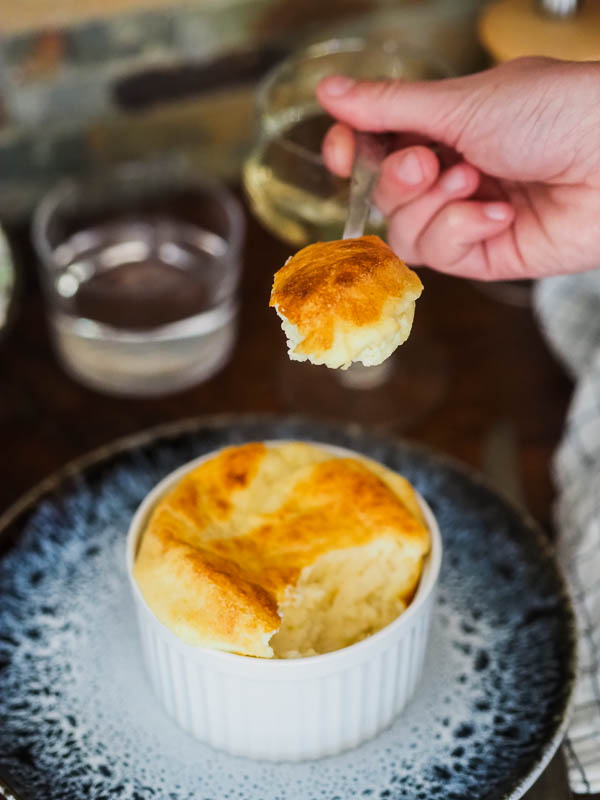
The name soufflé au fromage
Soufflé au fromage, as we call this dish in French, comes from the past participle of the French verb souffler. Souffler means to blow, breathe, inflate, or puff. Knowing this, it’s obvious now that a soufflé is an egg-baked dish that rises a lot, and a cheese soufflé is with the addition of cheese.
What is the best cheese for a flavorful soufflé?
In France, we mainly use Comté cheese, but any hard cheese that melts well works. You may replace Comté by Emmental, Gruyère, Cheddar, Parmesan…).
Avoid choosing soft cheese. It would be too moist, and your soufflé might not rise.
The story of cheese soufflé
The history of soufflé dates back to the 18th century when it was served as a dessert at the French royal court.
Since then, the soufflé has become a traditional French dish and is often served as a main course or dessert in gourmet restaurants.
The exact origin of soufflé remains uncertain, but many historians agree that the dish was created by a French chef named Vincent de la Chapelle.
De la Chapelle published a cookbook in 1735 entitled “Le Cuisinier Moderne”, in which he described a recipe for a dish called “soufflet” that was very similar to what we call a soufflé today.
The main steps in preparing a soufflé
Make a bechamel, add egg yolks, then grated cheese and firm whipped egg whites. Grease and flour ramequins and bake in a high-temperature oven.
The ingredients
- butter
- flour
- milk
- eggs
- cheese: grated Comté or Gruyère, Beaufort, Tomme, Emmental, Parmesan…
- salt, pepper and nutmeg
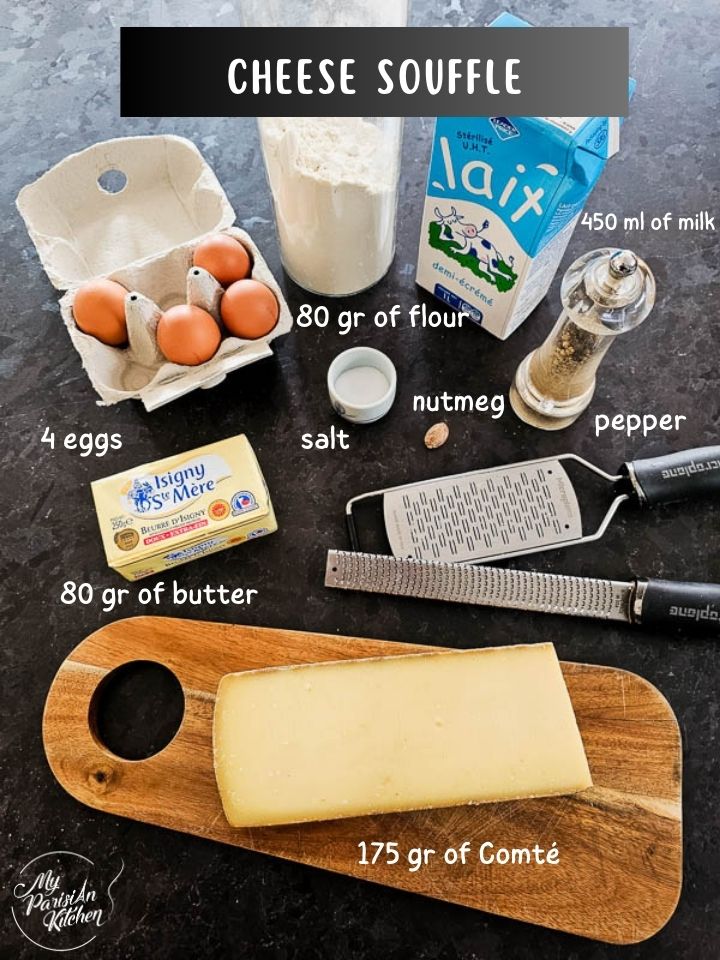
Make a bechamel
We make a béchamel sauce using the same amount of butter and flour.
Gently melt butter, then add all at ounce the flour and stir.
Once it’s well combined, leave to cook for a few minutes, stirring constantly with a wooden spatula. This will cook the flour. The result is what we call a roux.
Then, add the milk little by little over medium heat, stirring constantly with a wooden spatula or whisk. The mixture will gradually thicken.
Stop as soon as the texture is dense or at the first broth. You’re béchamel is ready.
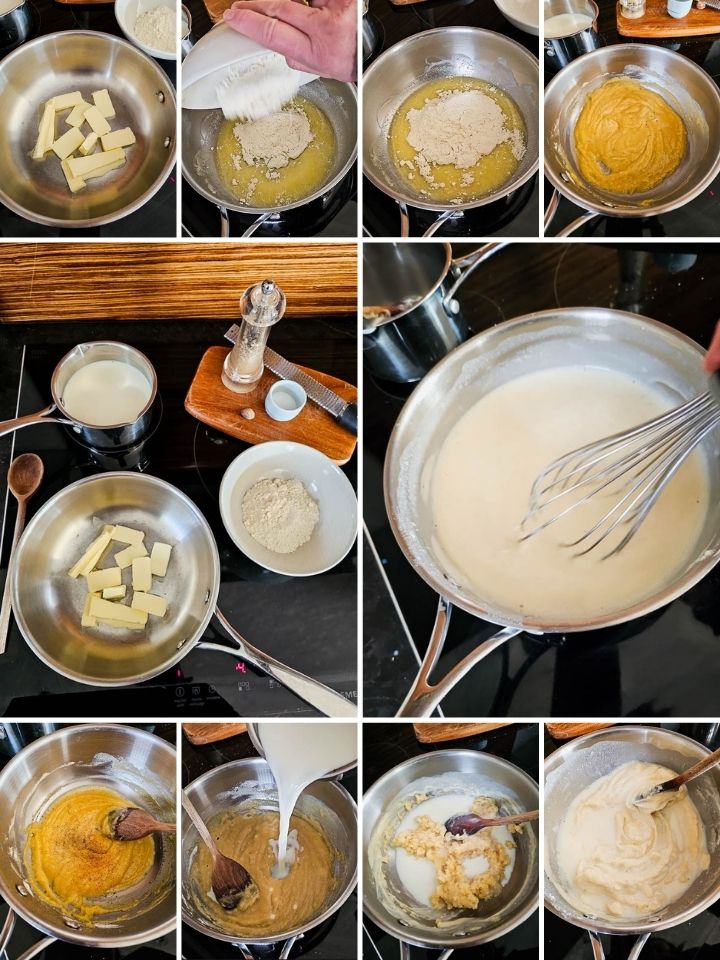
Add egg yolks, cheese, and whipped egg whites
Separate the egg whites from the yolks, placing the whites in a sufficiently large bowl (or in the bowl of a food processor), as the whites will be whipped until stiff.
Add the egg yolks to the béchamel off the heat. Add them one by one, mixing immediately.
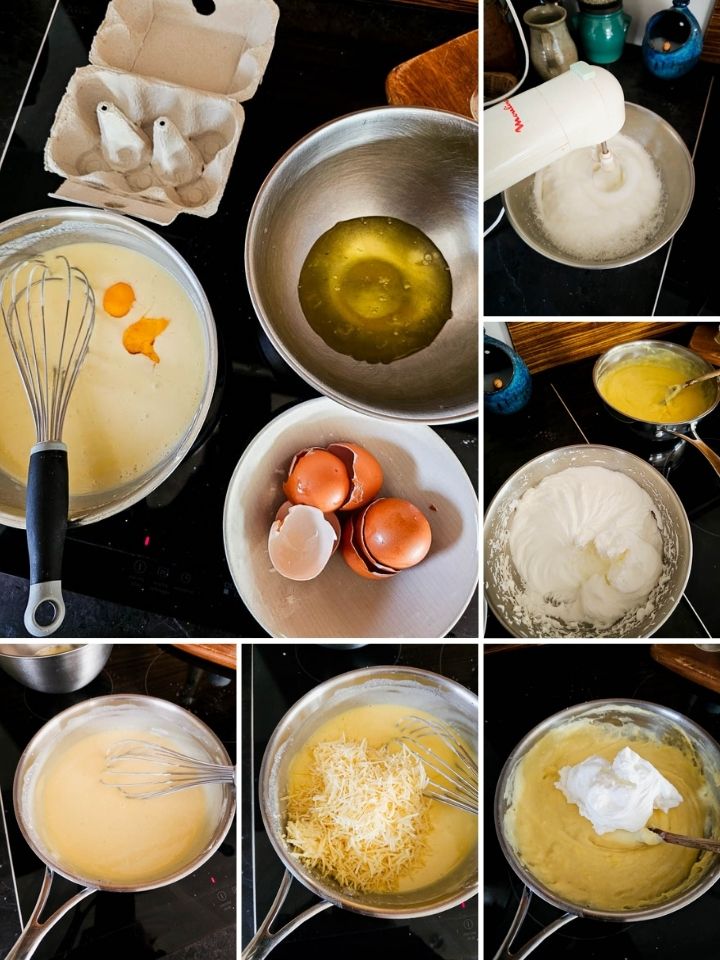
Then, still off the heat, add the grated cheese and combine. Finely grated cheese will melt correctly in the lukewarm béchamel.
Season with salt, pepper and nutmeg at any time, either at the beginning of the béchamel or at the end with the grated cheese. Be careful not to add too much salt, as there’s a lot of cheese, which could make the sauce too salty.
Finally, whip the egg whites until stiff and fold them gently into the preparation. You don’t want to break the whipped egg whites otherwise, your soufflé won’t rise well.
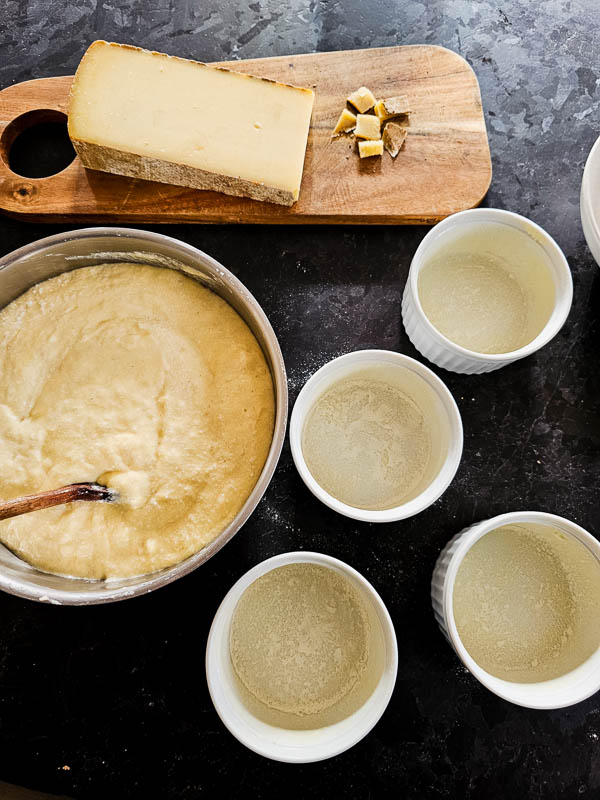
Prepare the molds, fill and bake
Butter and flour the individual ceramic ramekins. Butter the sides upward, and I’ll explain why right after.
Your ramequins must have straight sides. The usual size we use in France is 9cmX4xm 3.5inchX1.6inch.
If you don’t have ceramic baking dishes, you can use other individual molds, such as muffin tins, but adjust the baking time accordingly.
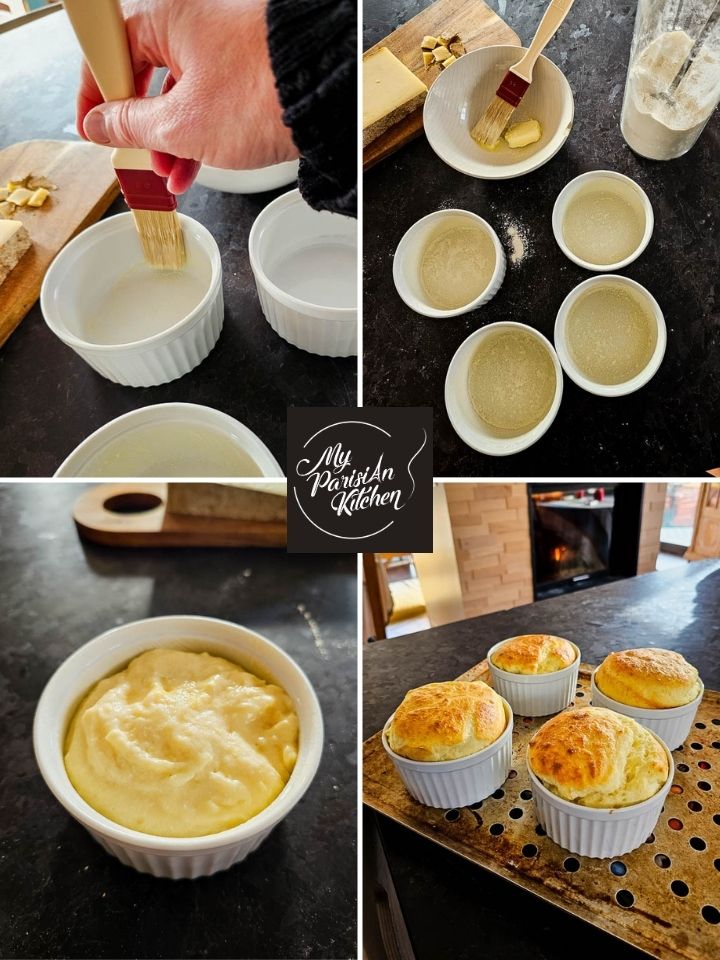
Fill individual ramekins ¾ full. The soufflé shall almost double in height.
Then bake for 10 minutes at 200°C / 390°F in a preheated oven, of course, and enjoy straight away.
Baking and serving tips
The soufflé should be baked in an oven preheated to a high temperature, 200°C / 390°F. It’s important not to open the oven door during baking, as this could cause the soufflé to fall over.
You want to get a light, cheezy, well-rised soufflé with a soft center, a little jiggly when you shake the dish.
Serve immediately, as you will only have a few minutes perfectly raised before your soufflés start to deflate. There are techniques to follow to help you succeed in getting a perfectly risen soufflé. However, it will inevitably reduce.
The golden rules for successful soufflés
Making the béchamel
In addition to the instructions above and in the recipe instructions, I tell you all about béchamel with a detailed recipe and tips in a dedicated article.
Use a finely grated hard cheese
It’s best to use a hard cheese so that it doesn’t bring too much moisture into the gratin, which may then be too soft and puffy.
Finely grate the cheese so that it immediately start to melt and mixes well with the béchamel sauce.
Prepare stiff whipped egg whites
Preparing stiff egg whites is a crucial step in making a successful soufflé. Whip egg whites until stiff and glossy. The tiny bubbles captured in the firm whipped egg whites will help soufflés to rise.
Be careful not to overbeat them, however, as this could cause them to become greasy.
Adding a pinch of salt may help, but many French chefs say it’s useless.
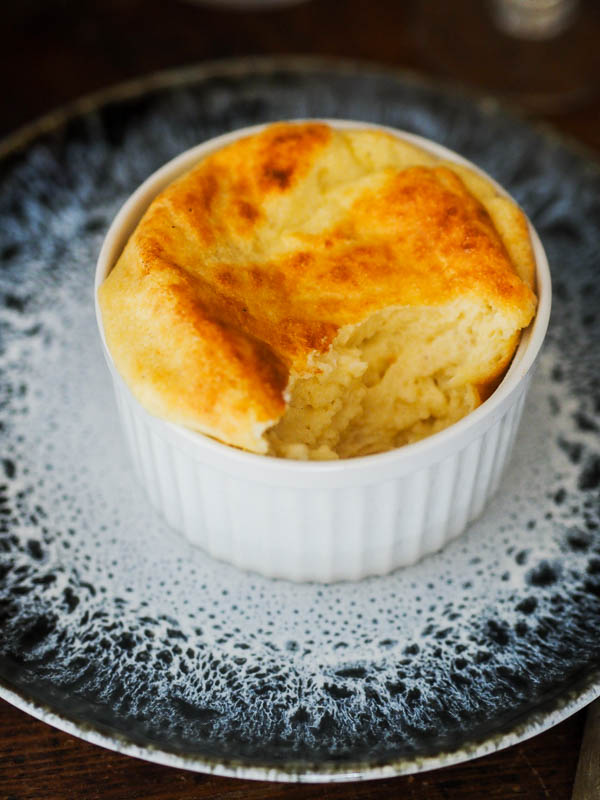
Butter the ramekins in a specific way
Ideally, use a kitchen brush or, eventually your fingers rather than kitchen paper to spread the butter. Use room temperature butter. It’s important that it’s soft enough to adhere generously to the sides.
Butter the bottom of the ramekins; then the most important is to butter the sides vertically, from bottom to top. This will create small vertical lines of butter that will help the soufflé to rise. It may seem nothing, but I’ve tried it this way and it seems to help.
What to serve with
- Serve as a starter alone or with green salad or crudités – raw vegetables (such as leeks in vinaigrette or grated carrots).
- Or as a main dish with any side : vegetables, pastas,…
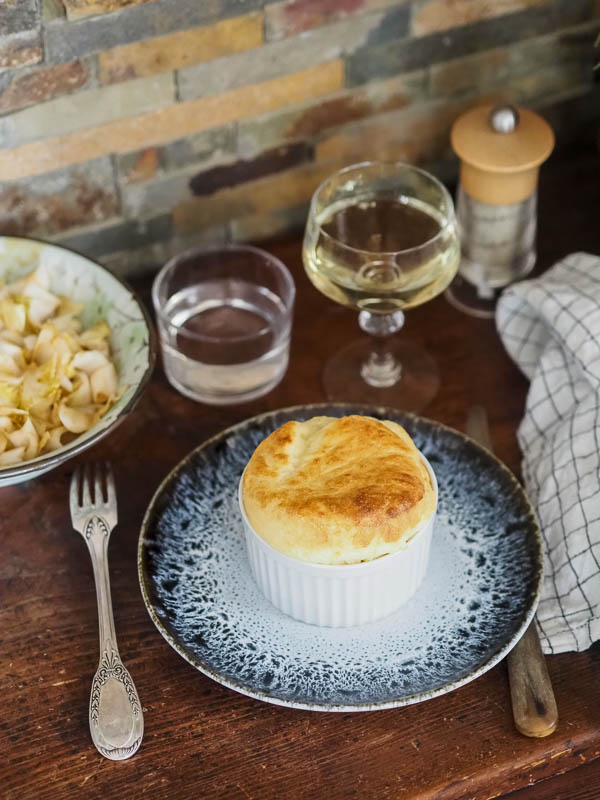
Other soufflés
- With legumes or vegetables. Either the bechamel base with precooked and drained vegetables (boiled or sautéed) or purée
- Sweet soufflé, the most decadent, is with chocolate, of course. I’ll post the recipe soon.
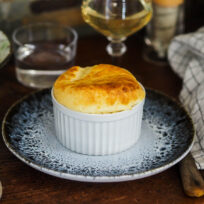
Cheese soufflé
Ingredients
- 80 gr butter 60 gr béchamel 20 gr molds
- 80 gr flour 60 gr béchamel 20 gr molds
- 450 ml milk
- 175 gr cheese grated cheese, Gruyere, Comté or any other hard cheese (Emmnetal)
- 4 eggs
- salt
- pepper freshly grounded
- nutmeg
Instructions
- Preheat oven to 200°C / 390°F.
Prepare the béchamel sauce
- In a saucepan, place 60g of butter cut into pieces and melt gently. When melted, add the flour all at once and mix immediately. Leave to cook for a few minutes, stirring as the mixture swells and foams, a sign that the flour is cooking.
- You can season with salt, pepper and nutmeg at this point or later.
- Then pour in the milk in several batches, stirring well until the milk is fully incorporated each time. Leave to cook for a few minutes over medium-high heat until the béchamel thickens. Stop at the first broth.
Add eggs and cheese
- Remove from the heat and stir in the egg yolks one by one.
- Then add the grated cheese and combine.
- Beat the egg whites until stiff. Gently fold into the preparation.
Grease the ramekins, fill and bake
- Butter the bottom and sides of the ramekins from bottom to top, this vertical direction will help the soufflés rise. Flour the molds and fill them ¾ full.
- Bake for 10 minutes and serve immediately.

You explained this so well…I’ve never made soufflé but feel emboldened to try !
Merci beaucoup Philippa.I hope my explanations will help